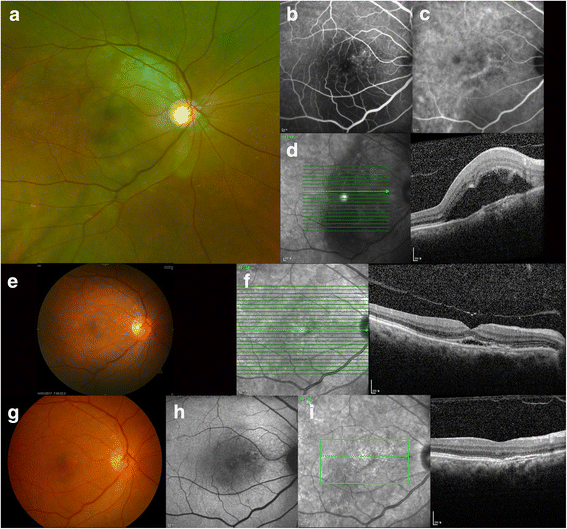Varicella zoster virus-associated Chorioretinitis: a case report
- PMID: 29402251
- PMCID: PMC5800090
- DOI: 10.1186/s12886-018-0696-3
Varicella zoster virus-associated Chorioretinitis: a case report
Abstract
Background: Chorioretinitis is an unusual form of varicella zoster virus (VZV)-associated uveitis, and no report has described VZV-associated chorioretinitis using serial optical coherence tomography (OCT) images obtained during the course of resolution.
Case presentation: A 61-year-old woman presented with acute, unilateral vision loss in her right eye. Her visual acuity was count fingers in the right eye and 16/20 in the left eye, and she exhibited skin vesicles on her right forehead. Slit lamp biomicroscopy, funduscopy, OCT, and intraocular fluid analysis were performed. The right eye exhibited multiple inflammatory lesions at the posterior pole, macular edema, and disc swelling on the fundus examination. OCT revealed predominant involvement of the choroid and the retinal pigment epithelium (RPE). Intraocular fluid analysis showed positivity for VZV. The patient was admitted and treated with intravenous acyclovir. Additional oral prednisolone was used to reduce the inflammatory reaction. After 2 weeks of treatment with acyclovir, the lesion resolved, with undulation of the RPE. Her final visual acuity was 20/20.
Conclusions: VZV-associated posterior uveitis may present as multifocal chorioretinitis. Intraocular fluid analysis is important to detect an infectious origin.
Keywords: Chorioretinitis; Herpesvirus 3; Human; Uveitis.
Conflict of interest statement
Ethics approval and consent to participate
This study was approved by the Institutional Review Board of Severance hospital (IRB No.4–2017-0828) and was conducted in accordance with the Declaration of Helsinki. Consent to participate from the patients was waived by the Institutional Review Board of Severance hospital (IRB No.4–2017-0828) as this was a retrospective chart review study.
Consent for publication
Written informed consent was obtained from the patient for publication of this case report and any accompanying images.
Competing interests
The authors declare that they have no competing interests.
Publisher’s Note
Springer Nature remains neutral with regard to jurisdictional claims in published maps and institutional affiliations.
Figures

References
-
- Engstrom RE, Jr, Holland GN, Margolis TP, Muccioli C, Lindley JI, Belfort R, Jr, Holland SP, Johnston WH, Wolitz RA, Kreiger AE. The progressive outer retinal necrosis syndrome. A variant of necrotizing herpetic retinopathy in patients with AIDS. Ophthalmology. 1994;101(9):1488–1502. doi: 10.1016/S0161-6420(94)31142-0. - DOI - PubMed
Publication types
MeSH terms
Substances
LinkOut - more resources
Full Text Sources
Other Literature Sources

